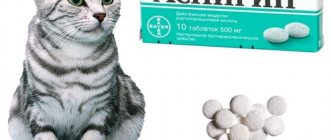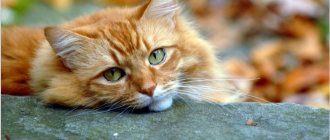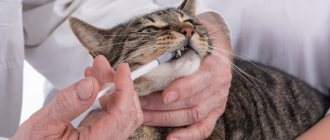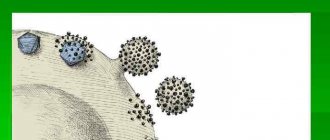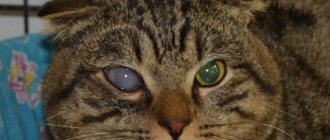Yellow discoloration of the mucous membranes and skin of a cat causes reasonable concern for animal owners. This is not an independent pathology, but a symptom of a number of diseases. What are the causes of the disease, ways to combat it, and features of caring for a sick pet?
Predisposing factors to the disease
Jaundice is caused by high levels of bilirubin in the blood. This bile pigment is formed in the cat's body as a result of the processing of hemoglobin from red blood cells. Hemoglobin is the most important component of blood, which saturates all organs and cells with oxygen. If hemoglobin is processed too quickly, the produced bilirubin does not have time to be utilized through the liver and gradually accumulates in the body, causing intoxication.
Jaundice often occurs due to liver disease.
Often, jaundice can occur against the background of concomitant tumors (cancer, cirrhosis, hepatitis), compressing the bile ducts, or due to taking certain medications. It can be triggered by rupture of the gallbladder, blood diseases, bacterial infections, obesity, and poor nutrition. Jaundice can be caused by various bacterial and viral infections, blood transfusions, hepatic lipidosis, and impaired bilirubin production.
Symptomatic diet and procedures
Most often, once the diagnosis is made, the veterinarian can give an approximate prognosis for the cat’s recovery.
In order for the animal to recover as quickly as possible, it is important to follow the doctor’s recommendations and adhere to the following rules:
- Administer medications in strictly prescribed dosages, without increasing or decreasing them. To ensure that the medicine gets into the cat’s body, experts recommend pouring it, dissolved in water, into the animal’s mouth using a syringe without a needle.
- It is necessary to strictly follow the diet. The diet should be balanced in terms of the ratio of proteins and carbohydrates, but it should not contain a lot of fat. You can buy food that is designed specifically for cats with liver failure. If this is not possible, then a veterinarian should advise the breeder on the menu.
- Offer your cat water to drink. It should be clean, cooled to room temperature.
- Cats with symptoms of jaundice and yellowing of the eyes should not be self-medicated. Such an “oversight” can kill the animal, since almost all drugs are toxic to the liver, which at this moment needs treatment.
- If the condition worsens (especially if the urine becomes dark and the feces become discolored, or streaks of blood appear in the animal’s feces), the cat should be urgently taken to the veterinarian. The gallbladder may have ruptured.
- The cat needs to be provided with peace; you cannot pick it up unless it comes running itself. We need to arrange a place for her to lie down.
- If the cat recovers, then you cannot deviate from the diet and return the animal to its previous lifestyle. The cat's liver is still very weakened, it needs to recover.
- If anemia occurs, it is recommended to switch your cat to food with a high iron content.
- Support the animal's immunity. To do this, you need to introduce vitamins and minerals into your diet. But this should be done only after consultation with a specialist.
A cat's yellowed eyes are a reason to contact a veterinarian, but not a reason to panic. In most cases, timely contact with specialists prevents the development of irreversible complications, and the animal can be cured. Veterinarians recommend that all breeders monitor their cats and undergo routine examinations.
Clinical signs of the disease
The clinical picture of the disease is often accompanied by anemia, signs of which may include drowsiness, slight weakness, loss of appetite and constant or periodic fever. The nature of such anemia greatly influences the general clinical signs. But in general, cats tolerate low hematocrit much more easily than dogs.
The most dangerous is hemolytic jaundice, which is characterized by the following symptoms:
- liver enlargement;
- refusal to eat;
- sudden increase in temperature, fever;
- enlarged lymph nodes and spleen;
- orange cal.
The disease progresses very quickly and it is almost impossible to notice its signs in time. It is difficult to cure this type of jaundice, and the animal often dies.
Obstructive jaundice is characterized by:
- nausea and vomiting;
- abdominal enlargement;
- sudden weight loss;
- anorexia;
- darkening of urine.
Most symptoms will depend on what caused the jaundice. But the common symptoms are always yellowing and dryness of the skin and mucous membranes, constipation, nausea and vomiting, and abdominal pain. With jaundice, urine becomes bright orange, and stool becomes completely white.
Yellow staining of mucous membranes is a very dangerous symptom.
There is frequent urination and severe thirst, sudden weight loss, mental disorders and internal bleeding. In advanced cases, jaundice can result in coma and death. Therefore, it is very important to start treatment in a timely manner. Once a cat's eyeballs, gums, and inside of its ears turn yellow, it dies within a few days.
Clinical manifestations of pathology, its causes
An attentive owner will definitely notice in the pet those signs that are characteristic of jaundice. Among them are diarrhea and vomiting, fever, loss of appetite. But the main symptom of the disease is reflected in its name. All the mucous membranes of the cat turn yellow, and the eyes are the first to make themselves known. The cat's urine becomes similar to orange juice, and the feces become gray-white.
Your cat's urination becomes more frequent and the daily volume of urine increases. Thirst increases. The functioning of the animal’s nervous system is also disrupted. He becomes aggressive or completely apathetic. The pet is losing weight. Sometimes a sick animal may experience internal bleeding.
The main predisposing factors for the occurrence of jaundice in pets are medications that can destroy red blood cells; infections of bacterial etiology; pathologies of the hematopoietic system; gallbladder ruptures. The latter is fraught with death. Jaundice can also be caused by tumors compressing the bile ducts; hepatic lipidosis; impaired secretion of bilirubin.
Diagnosis of jaundice in cats
After a thorough examination of the shaggy patient, the veterinarian should ask in detail about the signs and manifestations of the pathology, its duration, and find out about the nature of the stool. Laboratory tests will help a specialist confirm the diagnosis: general and biochemical blood tests of the cat, urine testing. Sometimes they resort to liver biopsy. A blood test can reveal severe anemia, helminthic infestations, and pathologies associated with the synthesis of liver enzymes. X-rays help determine the size and structure of the liver. Ultrasound examination allows you to more carefully assess the condition of the liver and differentiate tumors from cysts.
Infectious causes of hemolysis in cats
The destruction of red blood cells (hemolysis) in cats can occur for various reasons. A decrease in the number of red blood cells leads to the accumulation of bilirubin in the blood and severe oxygen starvation. The causes of hemolysis can be either infectious or non-infectious.
Infectious causes of hemolysis include:
- hemoplasmosis;
- babesiosis;
- cytozoonosis;
- dirofilariasis;
- infectious anemia;
- ehrlichiosis.
The causes of hemolytic anemia include some non-infectious diseases.
Diagnostics
Blood tests for different types of jaundice show different results. The detection of young forms of red blood cells in the blood, an increase or decrease in the concentration of bilirubin is of diagnostic importance. Testing the activity of alkaline phosphatase and liver transaminases is informative. The content of pigments - stercobilin, urobilinogen, bilirubin - is determined in urine and feces. If necessary, the veterinarian prescribes ultrasound and radiographic examinations.
Non-infectious causes of hemolysis in cats
Non-infectious hemolysis in cats is quite rare. Its main cause is idiopathic immune-mediated hemolytic anemia, which is conventionally divided into primary and secondary.
Primary hemolytic anemia
manifests itself in the form of jaundice, loss of appetite, pallor of the mucous membranes and heart murmurs.
Secondary anemia
caused by the use of certain medications (paracetamol, antibiotics or lidocaine), malignant neoplasms (etc.), heredity, low phosphate content in the body.
In rare cases, jaundice may be a consequence of hemolytic anemia.
Jaundice is just one symptom of immune-mediated hemolytic anemia. Therefore, it is important to correctly diagnose and prescribe proper treatment.
Is feline jaundice contagious to humans?
Some cat owners wonder how contagious feline jaundice is to humans. There can be no basis for such conclusions. After all, jaundice is only a symptom of a concomitant disease, and the parasites living in a cat’s liver are not dangerous to humans. The only disease that can pose a danger to people is leptospirosis, accompanied by jaundice. It is important to know how this disease is transmitted. A person can become infected with leptospirosis through contact with the urine and feces of a sick cat, so extreme caution will have to be used.
There is also no clear answer to the question: is jaundice contagious to other cats? After all, if it is caused by parasites or infectious causes, then any animal can become infected. If the disease is non-infectious, it does not pose any danger to surrounding cats.
Yellow discoloration of the mucous membranes and skin of a cat causes reasonable concern for animal owners. This is not an independent pathology, but a symptom of a number of diseases. What are the causes of the disease, ways to combat it, and features of caring for a sick pet?
How to make a diagnosis
Treatment of the disease directly depends on the cause of jaundice. During the period of treatment, the cat should be under the constant supervision of a veterinarian, preferably in a hospital. Hemolytic jaundice is often an indication for blood transfusion. After diagnosis, drug treatment is prescribed.
The following drugs can be used:
In some cases, the drug Globfel is used for treatment.
- Gemavit;
- Ceftriaxone;
- Ranitidine;
- Immunofan.
Sometimes the antiviral drug Globfel is prescribed, which is administered intramuscularly for at least three days. To ease your pet's suffering, your veterinarian may recommend the use of painkillers and antiemetic medications. But only in the absence of liver failure. Under no circumstances should you give a sick animal erythromycin, tetracycline or paracetamol. These drugs destroy the liver.
Many owners have a question: how long does jaundice last in a cat? If treatment is prescribed correctly and started on time, the cat may feel relief within 1-2 weeks. It is difficult to predict when the disease will completely recede. This depends not only on the cause of the jaundice, but also on the general state of the cat’s immunity, its age and other factors. It is important to remember that all drug treatment should only be prescribed by a qualified specialist. You should not self-medicate, as it can be fatal.
How is it diagnosed and how is it treated?
If parenchymal or obstructive jaundice is detected, you will need a diet with plenty of protein. Choose ready-made food created specifically for animals suffering from such diseases. Eliminate salt from your diet and add vitamins.
Drug treatment requires the owner to strictly adhere to the medication regimen. When it comes to the initial stage of jaundice, the cat will be taken to the hospital. Treatment is selected depending on the cause of the disease. For example, with the hemolytic form, blood transfusions are used. In any case, therapy consists of:
- Drugs that eliminate the cause of the disease, which include antibiotics and antitoxic drugs. This is etiotropic therapy.
- Medicines that can neutralize damaging factors, that is, what destroys the liver or anemia. This is called pathogenetic therapy.
- Antiemetics and painkillers are symptomatic treatment.
There are cases when it is impossible to do without surgery: removal of the gallbladder or part of the liver. It is also important to remember that no drugs should be given to an animal without consulting a doctor, because you can only worsen the situation. Folk remedies will also come to the rescue: a decoction of chamomile and rosehip. But this is only in addition to the main treatment, and not a replacement for it.
Prognosis and care for your cat
If you follow all the doctor’s prescriptions, start treatment at home in a timely manner, and strictly adhere to the dosage of medications, then the prognosis for jaundice will be optimistic. Diet for jaundice is no less important. The cat should be fed with special food for animals with liver diseases, containing a lot of easily digestible protein.
Eliminate everything salty, fried, fatty or spicy from your diet. Be sure to add vitamins B, C, K1 and PP to your food. During the entire period of therapy, it is important to carefully monitor any changes in the cat's condition. Thus, a sharp darkening of urine or light-colored feces can serve as a signal of a ruptured gallbladder.
Why did the cat turn yellow?
Taking into account a number of reasons
jaundice that causes this pathological manifestation is divided into only three types:
2. Hepatic jaundice is a consequence of liver disease. It could be:
Liver diseases will also be accompanied by vomiting, loss of appetite, and changes in the color of urine and feces.
3. Mechanical (subhepatic) jaundice occurs when bile stagnates in the bile ducts. This is a consequence of diseases such as:
Disease prevention
Regular vaccination is one of the measures to prevent jaundice.
To avoid contracting jaundice, you must follow some mandatory measures.
These include:
- high-quality and balanced diet;
- regular deworming;
- carrying out preventive examinations at the veterinarian;
- mandatory timely vaccination;
- compliance with nutritional standards.
If you comply with all these requirements, your cat will not have any health problems.
Common liver disease
, arising as a result of poisoning, gastritis, toxicosis and infection.
Cats have acute and chronic forms. Cats get jaundice
more often than people. Feline hepatitis is not transmitted to humans.
The liver is a powerful filter in the body. It cleanses the blood of poisons, toxins, infections, produces bile for proper digestion, regulates hormonal levels and metabolism. Every day a lot of stress is placed on it, and stressful situations (illness, poisoning) can lead to its inflammation.
Owners' fears: how justified are they?
Some breeders have the opinion that jaundice in a cat is contagious to the person himself. How justified is this point of view? In principle, it has nothing to do with reality. Let us repeat once again that jaundice itself is only a symptom of the underlying disease. Yes, you can become infected with worms from a cat, but specifically feline liver parasites are not dangerous for humans. Tumors and other pathologies of the liver or spleen will not pass to you either. So why did such a stupid but widespread belief arise?
It's simple. Some people think that this pathology is transmitted to humans through association with hepatitis A, B and C, which are characteristic of humans. Cat jaundice does not pose any danger to your health and the health of your children! Of course, this does not relieve you of the need to monitor the condition of your pet, since some diseases that are fatal to cats are contagious to humans. Good luck to you and your cat on your journey to overcoming jaundice!
Signs of hepatitis
Regardless of the type of jaundice pathogen, the symptoms of the disease are the same. The first most obvious sign is yellowing of the mucous membranes. Jaundice in cats causes a yellowish tint to the tongue, lips and gums. The white of the eye also changes color. When touched on the right side or stomach, the pet becomes very nervous, gets angry, hisses or bites. This indicates pain in this area.
During hepatitis in a cat, the feces become light brown, mustard or white. Urine, on the contrary, becomes bright orange. Dehydration, fever, weight loss due to lack of appetite are also possible, and in advanced stages - internal bleeding and coma.
Symptoms
Almost all types of jaundice are associated with a persistent increase in bilirubin in the blood serum and its deposition in tissues. Clinical signs of jaundice are associated with this feature of the development of the disease process.
The skin is yellow in color - from pale straw to saffron. The mucous membranes and sclera of the eyes are also stained. In cats, this symptom is most noticeable on the auricle and oral mucosa; the whites of the eyes can remain normal color for a long time.
Due to the high toxicity of indirect bilirubin, an increase in its concentration in the blood leads to severe disorders of the nervous system - changes in consciousness and degenerative disorders of the brain.
Depending on the causes and type of jaundice, the following symptoms may appear:
Hepatitis treatment
This or that form of hepatitis is indicated by different symptoms and treatment, accordingly, will differ. First of all, it is necessary to eliminate the cause of the disease.
- In case of poisoning, it is necessary to give an adsorbent - for example, activated carbon - in the first hours. You may need a saline drip.
- Infectious hepatitis requires antibiotics. They are prescribed by a veterinarian depending on the causative agent of the disease.
- Be sure to give B vitamins and immunomodulators. Hepatoprotectors will help restore liver cells faster.
- For severe pain, inject Drotaverine.
- An antihistamine is prescribed at the discretion of the veterinarian, since a treatment regimen based on a significant amount of drugs can cause allergies.
- As an additional therapy, it is acceptable to give the cat a decoction of rose hips (as a source of vitamin C) and chamomile for additional disinfection.
- A therapeutic diet is required. Most likely, the veterinarian will prescribe feeding only cereals - buckwheat, rice, oatmeal. After 7 days from the start of drug therapy, it will be possible to introduce poultry meat (chicken breast, turkey fillet) or lean fish (hake, tuna).
If the bile ducts are compressed, then most likely an operation will be prescribed.
Disease prognosis
The speed of your pet’s recovery depends on timely diagnosis, the correct treatment regimen, the body’s sensitivity to certain medications, and nutritional therapy. The animal must be under your close attention. You are required to follow all veterinarian recommendations. You cannot change the dosage of medications on your own. If your cat has liver failure, be vigilant even at night, because... the condition may worsen sharply, and a doctor will be urgently needed.
Jaundice in cats does not go away without a trace. Liver diseases strain the organ's endurance. Periodic medication support may be required.
Need to know
To the question “How quickly does jaundice go away in cats?” it is difficult to give a definite answer. But timely treatment and good care will help defeat the disease in a short time. Cat owners can sleep peacefully, since jaundice in animals is not contagious to humans. The only disease that can be transmitted to humans is leptospirosis, which causes jaundice. It is transmitted through the feces and urine of a sick cat. So be extremely careful.
A great way to prevent disease is prevention:
- proper and balanced nutrition;
- body weight control; it is important to prevent your pet from becoming obese;
- vaccination;
- carrying out antihelminthic therapy at least twice a year;
- regular visits to the veterinarian;
- taking vitamin complexes.
Pets need not only to be loved, but also to be properly cared for.
Prevention
For prevention, follow simple measures: keep bowls and floors clean, provide clean water in the right quantity, give deworming medications once a quarter, regularly give vitamins, do not overfeed, feed only fresh food and high-quality ready-made food. Try to prevent the animal from coming into contact with stray cats.
Jaundice in cats has specific symptoms.
Jaundice is quite difficult for cats to tolerate. The reasons for its development include an increase in the level of bilirubin in the body, which is a product of the processing of red blood cells in the bone marrow, liver and spleen.
The liver of a healthy animal actively uses, secretes and absorbs bilirubin. And if its level is elevated, then this serves as a signal that the liver is unable to maintain the correct balance of this substance.
If you suspect that your cat has jaundice, then do not start any treatment yourself, without appropriate tests and examination by a specialist.
There are several main symptoms of jaundice. The color of the cat's skin changes to yellow, which is especially noticeable at the base of the ears; the whites of the eyes and gums also become yellowish. It becomes difficult for the animal to breathe, vomiting and diarrhea are observed.
The general condition of the pet is lethargic and depressed. No appetite. In addition, with jaundice, the cat begins to noticeably lose weight and experiences constant thirst. There is bloating and increased urination.
The most important of these symptoms is a decrease or complete loss of appetite.
Causes of the disease
The causes of the disease may differ significantly from each other, despite the general similarity of symptoms. One way or another, only a veterinary specialist can make a diagnosis and prescribe a course of treatment.
So, pre-hepatic causes, meaning the breakdown of red blood cells even before they pass through the liver, include:
- low phosphate content;
- the body's reaction to blood transfusion;
- heartworms;
- reaction to medications;
- hemolytic immune-related anemia;
Hepatic causes of jaundice in cats include exclusively liver diseases, which may include various infections, cancer, cirrhosis, cholangitis, hepatitis, cholangiohepatitis, hepatic lipidosis, as well as reactions to certain medications and certain toxins.
Posthepatic causes include disorders that occur when blood passes through the liver. This includes blocking the outflow of bile, diseases of the pancreas and bile ducts, as well as inflammation of the gallbladder, cancer, and stones. In addition, such reasons include intestinal diseases, as a result of which the bile ducts become blocked.





